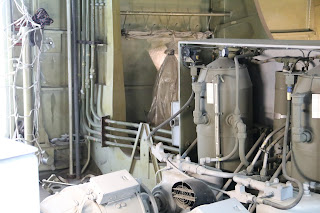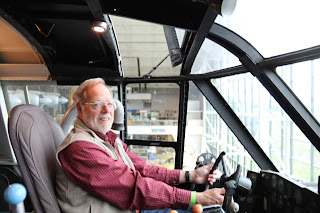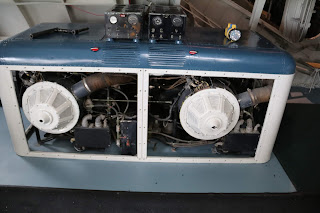The name Spruce Goose was given to the plane by the news media and Howard Hughes hated it. In fact, the majority of the plane is constructed of birch, not spruce. The Spruce Goose has the longest wingspan of any plane ever to fly and the fuselage is roughly the size of a 747. There is a plane under construction by Stratolaunch Systems Corporation scheduled to fly in 2019 that will have a longer wingspan.
https://en.wikipedia.org/wiki/Stratolaunch_Systems#Carrier_aircraft
The Spruce Goose joints were nailed together with glue and the nails removed after the glue set. That was done to keep the weight down and there must have been a million nails in that puppy. The photo below is one of the joints exposed where a second door was cut to make ingress/egress practical in the museum. The green area is painted wood and the skin of the fuselage is birch plywood. I suspect the hole is where a nail was removed.
Notice hole in wood joint
It is difficult to get a sense of how large this plane is from photographs but maybe the following photos will help.
Entry doors. Notice man up on landing
Spruce Goose in the museum
When you enter the plane and turn to the right you can see down the fuselage. In the following photo the manikin in the photo is 6 feet and 1 inch tall. The fire suppression system was added to the aircraft after it was placed in storage. After the flight in 1947 Hughes built a special climate controlled hanger to house the plane and maintain a 300 man crew of workers to maintain the plane at an annual cost of one million dollars. The crew was reduced to 50 in 1962 and then disbanded after his death in 1976.
Looking down the fuselage to the tail
Entering the plane and turning to the left you see the area under the cockpit. This was the first plane to use hydraulics for control and the large electric motors, pumps, and fluid reservoirs as well as an electrical control center are located in this area.
The area under the cockpit
Electrical control panel
Hydraulics pumps
Hydraulics lines and reservoirs
Nose section beneath cockpit
Also located in this area are two radio antennas and Hughes on personal air filtration system. Because the fuselage is constructed of wood the radio antenna can be located inside. It is well known that Hughes was a germaphobe and the air filtration system was installed supplying filtered air directly to the pilot's seat.
One of two radio antenna
Air filtration system
The tube behind my head is the filtered air supply for Howard
When the Spruce Goose was moved to Oregon it had to be partially disassembled. It was during the disassembly that many beach balls were discovered inside the pontoons at the end of each wing. Hughes did not like to take chances and was worried about the pontoons springing a leak. He saw a beach ball and knew that was the solution he needed. He instructed his men to find as many beach balls as they could and they were filled with air and placed inside the pontoons. He also stationed eight men with fire extinguishers inside the wings behind each of the eight engines just in case the exhaust from an engine caught the wing on fire.
There was a pontoon under each wing. The plane is a boat.
Some of the beach balls found in the pontoons.
Notice the ladder in the photo below. That is where Howard Hughes climbed up to a hatch that opens on top of the aircraft He had a platform to stand on where he could direct the tow out of the hanger and into the bay. He is visible in the following youtube video doing just that.
A few more links of interest:
Rich is looking out into one of the wings.
Going up to the cockpit area we find lots of equipment. Two small aircraft engines are used to run generators to provide electrical power for the aircraft. The propellers are missing and the crew had to use special cranks to start the engines. It must have been noisy inside the cockpit.
Electrical power generation by two aircraft engines attached to generators.
The area behind the cockpit.
The windows on the left of the Assistant Flight Engineers Station were installed after the plane became available for public viewing in California. The public was not allowed to enter the aircraft and a platform built to allow them to peer in thru the windows.
Assistant Flight Engineers Station
More monitoring equipment
The flight engineer had to synchronize all eight engines from the panel shown in the photo below. The Spruce Goose was powered by eight 3000 horsepower Pratt and Whitney R-4360 engines. The engines were air cooled radial, piston engines with 28 cylinders, four rows of seven, with 56 spark plugs running from seven magnetos. Each engine consumed 109 gallons of fuel per hour at cruise speed.
Flight Engineers Station
Pilots seat where Howard Hughes sat
Your flight crew






















No comments:
Post a Comment